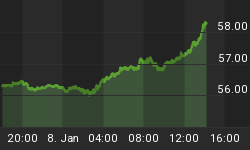Excerpt from edition dated March 5, 2007.
-
The yield curve (10s to 2s) was inverted at -15 bps on Wednesday, February 21, -12 bps on Friday, - 7 bps on Tuesday, February 27. Now it's -4 bps.
-
While sub-prime spreads were under extreme pressure, traditional junk, which has been "bulletproof", narrowed to 446 bps on Thursday and then widened to 455 on Monday, February 6.
-
The gold/silver ratio's recent decline made it to 46.7 on Monday, February 26, and the big move did not come until Thursday, March 1.
The rise in the ratio to 51.2 this morning is a fast move and was coincidental with the overall break in the hitherto hot games.
-
Cheerleaders have been plying their trade, with Barron's (March 2) front page featuring a cartoon of a grinning bull with a sword slashing a startled bear.
-
Commenting on increasing financial concerns on Wednesday, February 28, New York Fed President, Tom Geithner, said "Central banks need to stand prepared to make appropriate monetary adjustments if changes in financial conditions would otherwise threaten the achievement of the goals of price stability and sustainable economic growth.".
This means that the Fed is about to follow the decline in treasury bill rates with some grandstanding about cutting administered rates.
It is worth emphasizing that short-dated market rate of interest always increase with a boom and always decrease with the subsequent contraction. T-bill rates reached 5.18% on Friday, February 23 and have declined to 5.08% this morning. A confirmed downtrend would be bad.
-
Outside the big percentage drops in stocks and commodities (CRB down to 304 from 315.1 last Monday), changes in the credit markets seem appropriate to the significant loss of abilities by speculators to drive prices up.
-
On the brighter side, the ABX HE BBB crashed to a low of 73.06 on that fateful Tuesday and has recovered to 81.46 since. This is likely to be brief.
The gold/silver ratio, which reached 51.2 earlier today, has eased to 50.7.
-
Perhaps much of the initial panic is in the markets and, while some relief is possible, the overall action seems to be on a path that in the past has led to a liquidity crisis.
















